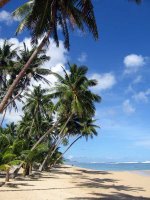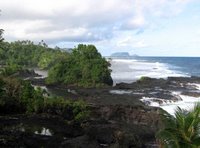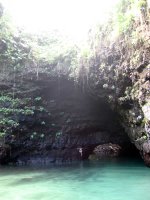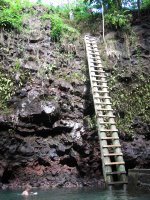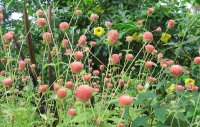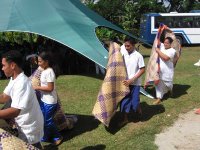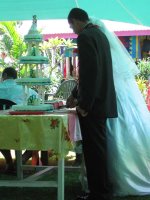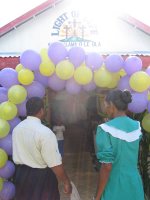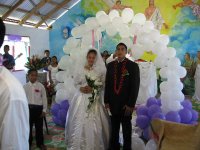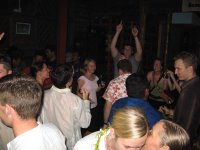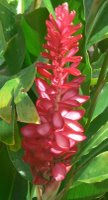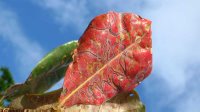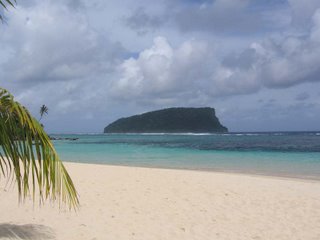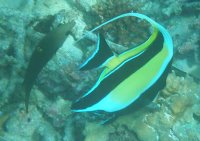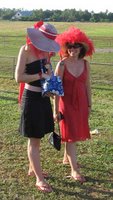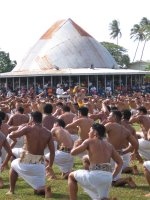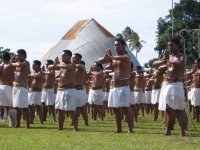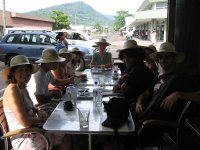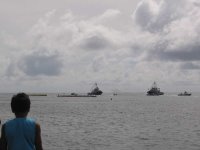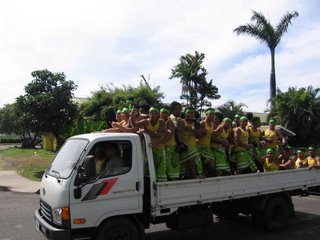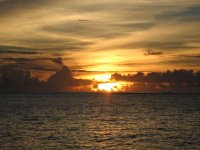 Off the south-east tip of 'Upolu lies Namua island. I've already written about it, but didn't really say all that much. This is a shame, as it is without a doubt my favourite place in Samoa. It warrants a far better description that I've previously given it.
Off the south-east tip of 'Upolu lies Namua island. I've already written about it, but didn't really say all that much. This is a shame, as it is without a doubt my favourite place in Samoa. It warrants a far better description that I've previously given it.It may not have the best beach in Samoa but it certainly has one of the most secluded. Just one family lives on Namua and they provide accommodation and meals for their guests. The only way to and from the island is in their little tinny. Upon reaching the small jetty on the main island in the village of Aleipata you have to hoist up a large pole with a white flag on it to attract their attention and let them know guests have arrived. You'll be greeted warmly by your hosts and most likely find yourself the subject of the curiosity of their young daughter.
 Guests stay on the side of the island facing the 'Upolu. The fales are open, with just woven coconut shutters for dealing with inclement weather. Mosquito nets are provided and that's a good thing too. Namu means mosquito and namua is the plural form - lots of mosquitoes - and the island lives up to its name (although I've stayed at several other places with far more). The family provide three meals a day and have lots of extremely tasty lemongrass tea. They just pick the lemongrass from their garden and put it in the kettle.
Guests stay on the side of the island facing the 'Upolu. The fales are open, with just woven coconut shutters for dealing with inclement weather. Mosquito nets are provided and that's a good thing too. Namu means mosquito and namua is the plural form - lots of mosquitoes - and the island lives up to its name (although I've stayed at several other places with far more). The family provide three meals a day and have lots of extremely tasty lemongrass tea. They just pick the lemongrass from their garden and put it in the kettle.There's not a great deal to do whilst you're there. It truly is a fantastic place to relax. The one thing I try to do every time I'm there however, is make my way around the island. At low tide it's possible to walk around the southern edge of the island and the reward is well worth it. The rocky point is a great place for snorkelling and I've spent a lot of time just sitting there watching the waves roll over the nearby reef break. It's beautiful.
 Round the southern tip and you discover steep cliffs stretching up over your head, with sea birds circling about searching for food. Carefully navigate the very slippery rocks for a couple of hundred metres and you reach another small headland. Round that and suddenly you stumble across a secluded little beach. I love it. The tracks of hermit crabs criss cross over the soft sand and a fantastic array of shells wash up on the shore. You really do feel like you're living in your own private tropical paradise.
Round the southern tip and you discover steep cliffs stretching up over your head, with sea birds circling about searching for food. Carefully navigate the very slippery rocks for a couple of hundred metres and you reach another small headland. Round that and suddenly you stumble across a secluded little beach. I love it. The tracks of hermit crabs criss cross over the soft sand and a fantastic array of shells wash up on the shore. You really do feel like you're living in your own private tropical paradise.You can spend hours there just sitting and watching the waves roll in and the hermit crabs scuttle by but don't forget to head back before the tide turns. Navigating the point as the water comes in makes the going much harder. The rocks get very slippery and when you're carrying a towel and camera and water, etc., it becomes a bit of a challenge.
Dinner is served between 6pm and 7pm. You know it's ready when the sound of a wooden drum punctuates the air and raises you from your afternoon nap. There's no electricty on the island save for that offered by a generator, so after you finish your dinner the generator is shut down and hurricane lamps provide soft light for your fale. Watch the last of the sunset, read a book and fall asleep to the soft sound of water lapping against the sands of the beach. And go to bed with a smile because when you wake up in the morning, you get to experience the beauty of Namua all over again.
